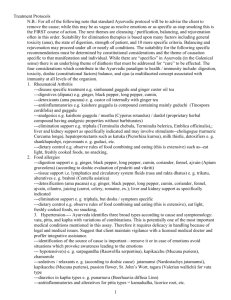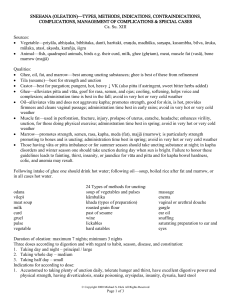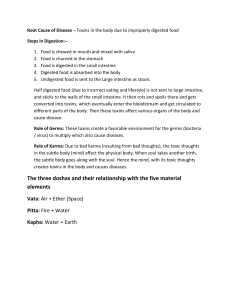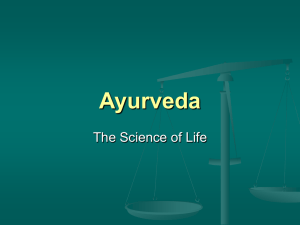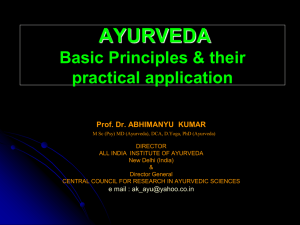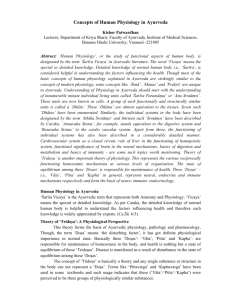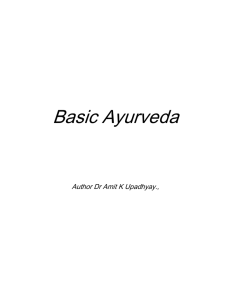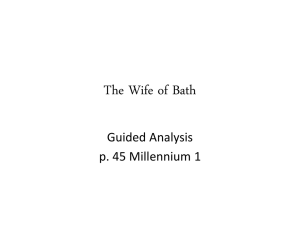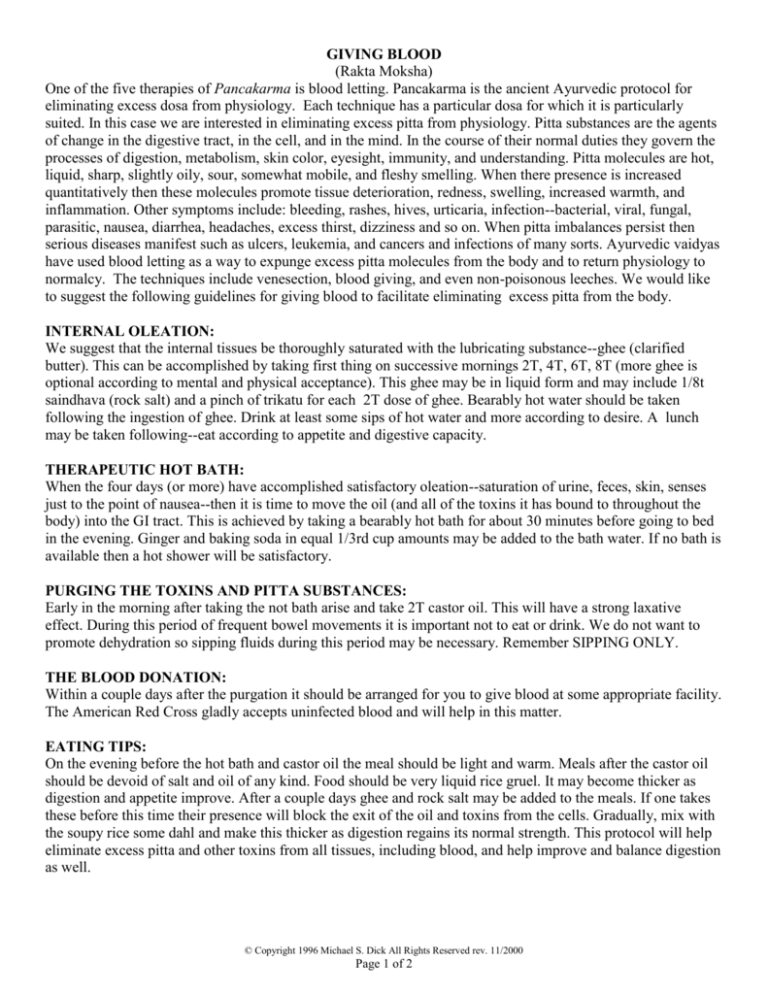
GIVING BLOOD
(Rakta Moksha)
One of the five therapies of Pancakarma is blood letting. Pancakarma is the ancient Ayurvedic protocol for
eliminating excess dosa from physiology. Each technique has a particular dosa for which it is particularly
suited. In this case we are interested in eliminating excess pitta from physiology. Pitta substances are the agents
of change in the digestive tract, in the cell, and in the mind. In the course of their normal duties they govern the
processes of digestion, metabolism, skin color, eyesight, immunity, and understanding. Pitta molecules are hot,
liquid, sharp, slightly oily, sour, somewhat mobile, and fleshy smelling. When there presence is increased
quantitatively then these molecules promote tissue deterioration, redness, swelling, increased warmth, and
inflammation. Other symptoms include: bleeding, rashes, hives, urticaria, infection--bacterial, viral, fungal,
parasitic, nausea, diarrhea, headaches, excess thirst, dizziness and so on. When pitta imbalances persist then
serious diseases manifest such as ulcers, leukemia, and cancers and infections of many sorts. Ayurvedic vaidyas
have used blood letting as a way to expunge excess pitta molecules from the body and to return physiology to
normalcy. The techniques include venesection, blood giving, and even non-poisonous leeches. We would like
to suggest the following guidelines for giving blood to facilitate eliminating excess pitta from the body.
INTERNAL OLEATION:
We suggest that the internal tissues be thoroughly saturated with the lubricating substance--ghee (clarified
butter). This can be accomplished by taking first thing on successive mornings 2T, 4T, 6T, 8T (more ghee is
optional according to mental and physical acceptance). This ghee may be in liquid form and may include 1/8t
saindhava (rock salt) and a pinch of trikatu for each 2T dose of ghee. Bearably hot water should be taken
following the ingestion of ghee. Drink at least some sips of hot water and more according to desire. A lunch
may be taken following--eat according to appetite and digestive capacity.
THERAPEUTIC HOT BATH:
When the four days (or more) have accomplished satisfactory oleation--saturation of urine, feces, skin, senses
just to the point of nausea--then it is time to move the oil (and all of the toxins it has bound to throughout the
body) into the GI tract. This is achieved by taking a bearably hot bath for about 30 minutes before going to bed
in the evening. Ginger and baking soda in equal 1/3rd cup amounts may be added to the bath water. If no bath is
available then a hot shower will be satisfactory.
PURGING THE TOXINS AND PITTA SUBSTANCES:
Early in the morning after taking the not bath arise and take 2T castor oil. This will have a strong laxative
effect. During this period of frequent bowel movements it is important not to eat or drink. We do not want to
promote dehydration so sipping fluids during this period may be necessary. Remember SIPPING ONLY.
THE BLOOD DONATION:
Within a couple days after the purgation it should be arranged for you to give blood at some appropriate facility.
The American Red Cross gladly accepts uninfected blood and will help in this matter.
EATING TIPS:
On the evening before the hot bath and castor oil the meal should be light and warm. Meals after the castor oil
should be devoid of salt and oil of any kind. Food should be very liquid rice gruel. It may become thicker as
digestion and appetite improve. After a couple days ghee and rock salt may be added to the meals. If one takes
these before this time their presence will block the exit of the oil and toxins from the cells. Gradually, mix with
the soupy rice some dahl and make this thicker as digestion regains its normal strength. This protocol will help
eliminate excess pitta and other toxins from all tissues, including blood, and help improve and balance digestion
as well.
© Copyright 1996 Michael S. Dick All Rights Reserved rev. 11/2000
Page 1 of 2
Thin
Frothy
Transparent
Quick coursing }V¨TA
Expansive
Vermilion or black hue
Non-slimy
INDICATIONS OF VITIATED BLOOD
Su. Su. XIV.19
Deranged by bile
Blue, yellow, green or
brown
}PITTA
Fishy smell
Thin shun by flies and ants
Cold
Glossy
Thick
}KAPHA
Color of gairika or flesh
tendon
Slow in secreting or running
Excessively slimy
CONTRAINDICATIONS FOR RAKTA MOKÁA
Su Su XIV.21-27
Generalized edema
Cloudy day
Extreme constipation
An intumescence in a weak
Full exposure to cold and
Suppression of flatus
and enfeebled person from
wind
Suppression of urine
excessive use of acid food
Lack of (incomplete /
Timid disposition
Jaundice
improper) diaphoresis
One overcome with sleep
Hemorrhoids
Empty stomach
Extremely cold or hot
Abdominal dropsy
Fatigue and exhaustion
season
Pregnancy
Swooning
Over heated
Pulmonary consumption
Poisoning
(shosha)
Intoxication
Cakradatta LXXVIII22-24
below age 16
excessively sudated
internal hemorrhage
vomiting
above 70 years
v±tika disorders
dyspnea
anemia
after blood letting
pregnancy
cough
general anasarca
non-uncted
puerperium
diarrhea
after intake of sneha
non-sudated
indigestion
udaroga
and PK
Complications of surgery—
Hemorrhage
Shirobhitapa
Violent headache
Blindness or loss of sight
Adhimantham (ophthalmia)
Loss of vital principles
(dh±tu kÃaya)
Convulsions
Paralysis (ek±nga vik±ra)
Hemiplegia (pakñgh±ta)
Thirst
Signs of complete and successful blood letting—
Feeling of lightness
Alleviation of pain in affected part
Abatement of the disease
General sense of cheerfulness
Burning sensation
Hiccough
Cough
Breathlessness
Jaundice
Death
Benefits of bloodletting—
Immunity from all types of skin diseases
Sarcomata
Aneurysm
Edema
Diseases brought about by vitiated blood such as ovarian tumor, carbuncle, erysipelas, etc.
© Copyright 1996 Michael S. Dick All Rights Reserved rev. 11/2000
Page 2 of 2



